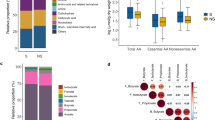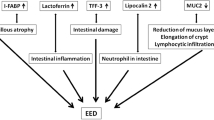Abstract
Background
Nutrient deficiencies limit the growth and turnover of intestinal mucosa, but studies assessing whether specific nutrients protect against or improve environmental enteric dysfunction (EED) are scarce. We aimed to investigate associations between nutrient intake and EED assessed by lactulose:mannitol (L:M) ratio, anti-1-antitrypsin, myeloperoxidase (MPO), and neopterin (NEO) among children 9–24 months in Bhaktapur, Nepal.
Methods
Among 231 included children, nutrient intake was assessed monthly by 24 h recalls, and 3-month usual intake was estimated using Multiple Source Method. Associations between nutrient intake and L:M ratio (measured at 15 months) were assessed using multiple linear regression, while associations between nutrient intake and fecal markers (measured quarterly) were assessed using Generalized Estimating Equations (GEE) models.
Results
We found that associations between nutrient intake from complementary food and L:M ratio, alpha-1-antitrypsin (AAT), MPO and NEO were generally negative but weak. The only significant associations between nutrient intake (potassium, magnesium, phosphorous, folate, and vitamin C) and markers for intestinal inflammation were found for MPO.
Conclusion
Negative but weak associations between nutrient intake and markers of intestinal inflammation were found. Significant associations between several nutrients and MPO might merit further investigation.
Similar content being viewed by others
Log in or create a free account to read this content
Gain free access to this article, as well as selected content from this journal and more on nature.com
or
References
Owino, V. et al. Environmental enteric dysfunction and growth failure/stunting in global child health. Pediatrics 138 pii: e2016064117 (2016).
Syed, S., Ali, A. & Duggan, C. Environmental enteric dysfunction in children. J. Pediatr. Gastroenterol. Nutr. 63, 6–14 (2016).
Crane, R. J., Jones, K. D. & Berkley, J. A. Environmental enteric dysfunction: an overview. Food Nutr. Bull. 36, S76–S87 (2015).
The MAL-ED Network Investigators. The MAL-ED study: a multinational and multidiciplinary approach to understand the relationship between enteric pathogens, malnutrition, gut physiology, physical growth, cognitive development, and immune responses in infants and children up to 2 years of age in resource-poor environments. Clin. Infect. Dis. 59(Suppl 4), S193–S206 (2014).
Kosek, M. et al. Assessment of environmental enteropathy in theMAL-ED cohort study: theoretical and analytic framework. Clin. Infect. Dis. 59(Suppl 4), S239–S247 (2014).
Brown, E. M. et al. Diet and specific microbial exposure trigger features of environmental enteropathy in a novel murine model. Nat. Commun. 6, 7806 (2015).
Ziegler, T. R. et al. Trophic and cytoprotective nutrition for intestinal adaptation, mucosal repair, and barrier function. Annu. Rev. Nutr. 23, 229–261 (2003).
Smith, H. E. et al. Multiple micronutrient supplementation transiently ameliorates environmental enteropathy in Malawian children aged 12-35 months in a randomized controlled clinical trial. J. Nutr. 144, 2059–2065 (2014).
Wang, A. Z. et al. A combined intervention of zinc, multiple micronutrients, and albendazole does not ameliorate environmental enteric dysfunction or stunting in rural malawian children in a double-blind randomized controlled trial. J. Nutr. 147, 97–103 (2017).
Manary, M. J. et al. Perturbed zinc homeostasis in rural 3-5-y-old Malawian children is associated with abnormalities in intestinal permeability attributed to tropical enteropathy. Pediatr. Res. 67, 671–675 (2010).
Thurnham, D. I. et al. Innate immunity, gut integrity, and vitamin A in Gambian and Indian infants. J. Infect. Dis. 182(Suppl 1), S23–S28 (2000).
Ueno, P. M. et al. Alanyl-glutamine promotes intestinal epithelial cell homeostasis in vitro and in a murine model of weanling undernutrition. Am. J. Physiol. Gastrointest. Liver Physiol. 301, G612–G622 (2011).
Shrestha, P. S. et al. Bhaktapur, Nepal: theMAL-ED birth cohort study in Nepal. Clin. Infect. Dis. 59(Suppl 4), S300–S303 (2014).
Morseth, M. S., et al. Severely inadequate micronutrient intake among children 9-24 months in Nepal-The MAL-ED birth cohort study. Matern. Child Nutr. 14, e12552, 2017.
Lang, D & MAL-ED Network Investigators. Opportunities to a ssess factors contributing to the development of the intestinal microbiota in infants living in developing countries. Microb. Ecol. Health Dis. 26, 28316 (2015).
Ministry of Health and Population, Government of Nepal. NEPAL Integrated Management of Acute Malnutrition (IMAM) Guideline Draft 7: 8 February 2017 (Ministry of Health and Population (MoHP), Government of Nepal, 2017)
Bhandari, S. & Banjara, M. R. Micronutrients deficiency, a hidden hunger in Nepal: prevalence, causes, consequences, and solutions. Int. Sch. Res. Notices 2015 276469 (2015).
Platts-Mills, J. A. et al. Pathogen-specific burdens of community diarrhoea in developing countries: a multisite birth cohort study (MAL-ED). Lancet Glob. Health 3, e564–e575 (2015).
FAO. International System of Food Data Systems (INFOODS). http://www.fao.org/infoods/infoods/tables-and-databases/faoinfoods-databases/en/.
Harttig, U. et al. The MSM program: web-based statistics package for estimating usual dietary intake using the Multiple Source Method. Eur. J. Clin. Nutr. 65 (Suppl 1), S87–S91 (2011).
Psaki, S. R. et al. Measuring socioeconomic status in multicountry studies: results from the eight-country MAL-ED study. Popul. Health Metr. 12, 8 (2014).
Working Group on Infant and Young Child Feeding Indicators. Developing and Validating Simple Indicators of Dietary Quality and Energy Intake of Infants and Young Children in Developing Countries: Summary of findings from analysis of 10 data sets. (Food and Nutrition Technical Assistance Project (FANTA), Washington DC, 2006).
FAO/WHO. Vitamin and Mineral Requirements in Human Nutrition (FAO/WHO, 2002)
Allen, L. H. B vitamins in breast milk: relative importance of maternal status and intake, and effects on infant status and function. Adv. Nutr. 3, 362–369 (2012).
Rice, A. L. et al. Maternal vitamin A or beta-carotene supplementation in lactating bangladeshi women benefits mothers and infants but does not prevent subclinical deficiency. J. Nutr. 129, 356–365 (1999).
WHO. Complementary Feeding of Young Children in Developing Countries: a Review of Current Scientific Knowledge (World Health Organization, Geneva, 1998).
FAO. Human Energy Requirements (FAO, Rome, 2004)
Lunn, P. G., Northrop-Clewes, C. A. & Downes, R. M. Intestinal permeability, mucosal injury, and growth faltering in Gambian infants. Lancet 338, 907–910 (1991).
Campbell, R. K. Environmental Enteric Dysfunction in Early Childhood: Bridging the Gap Between Diet and Stunting in a Randomized Trial of Complementary Food Supplementation in Rural Bangladesh. PhD thesis, John Hopkins University, Baltimore, MD (2016).
Colston, J. M. et al. A methodologic framework for modeling and assessing biomarkers of environmental enteropathy as predictors of growth in infants: an example from a Peruvian birth cohort. Am. J. Clin. Nutr. 106, 245–255 (2017).
McCormick, B. J. et al. Dynamics and trends in fecal biomarkers of gut function in children from 1-24 months in the MAL-ED study. Am. J. Trop. Med. Hyg. 96, 465–472 (2017).
Krebs, N. F. Bioavailability of dietary supplements and impact of physiologic state: infants, children and adolescents. J. Nutr. 131, 1351S–1354S (2001).
Yatsunenko, T. et al. Human gut microbiome viewed across age and geography. Nature 486, 222–227 (2012).
Velly, H., Britton, R. A. & Preidis, G. A. Mechanisms of cross-talk between the diet, the intestinal microbiome, and the undernourished host. Gut Microbes 8, 98–112 (2017).
Campbell, R. et al. Association between urinary biomarkers of total sugars intake and measures of obesity in a cross-sectional study. PLoS ONE 12, e0179508 (2017).
Morseth, M. S. et al. Environmental enteropathy, micronutrient adequacy and length velocity in Nepalese children - the MAL-ED Birth Cohort Study. J. Pediatr. Gastroenterol. Nutr. (2018) 10.1097/MPG.0000000000001990.
Hansberry, D. R. et al. Fecal myeloperoxidase as a biomarker for inflammatory bowel disease. Cureus 9, e1004 (2017).
Reif, S. et al. Pre-illness dietary factors in inflammatory bowel disease. Gut 40, 754–760 (1997).
Bender, R. & Lange, S. Adjusting for multiple testing--when and how? J. Clin. Epidemiol. 54, 343–349 (2001).
Dewey, K. G. & Brown, K. H. Update on technical issues concerning complementary feeding of young children in developing countries and implications for intervention programs. Food and Nutrition Bulletin 24, 5–28 (2003).
Acknowledgements
We thank the staff, children, and caregivers of the MAL-ED Bhaktapur site for their contributions. This work was supported by the Bill & Melinda Gates Foundation (grant number OPP47075); the Foundation for the NIH and the National Institutes of Health, Fogarty International Center.
Author information
Authors and Affiliations
Corresponding author
Ethics declarations
Competing interests
The authors declare no competing interests.
Additional information
Publisher's note: Springer Nature remains neutral with regard to jurisdictional claims in published maps and institutional affiliations.
Rights and permissions
About this article
Cite this article
Morseth, M.S., Strand, T.A., Torheim, L.E. et al. Nutrient intake and environmental enteric dysfunction among Nepalese children 9–24 months old—the MAL-ED birth cohort study. Pediatr Res 84, 509–515 (2018). https://doi.org/10.1038/s41390-018-0108-7
Received:
Revised:
Accepted:
Published:
Issue date:
DOI: https://doi.org/10.1038/s41390-018-0108-7



